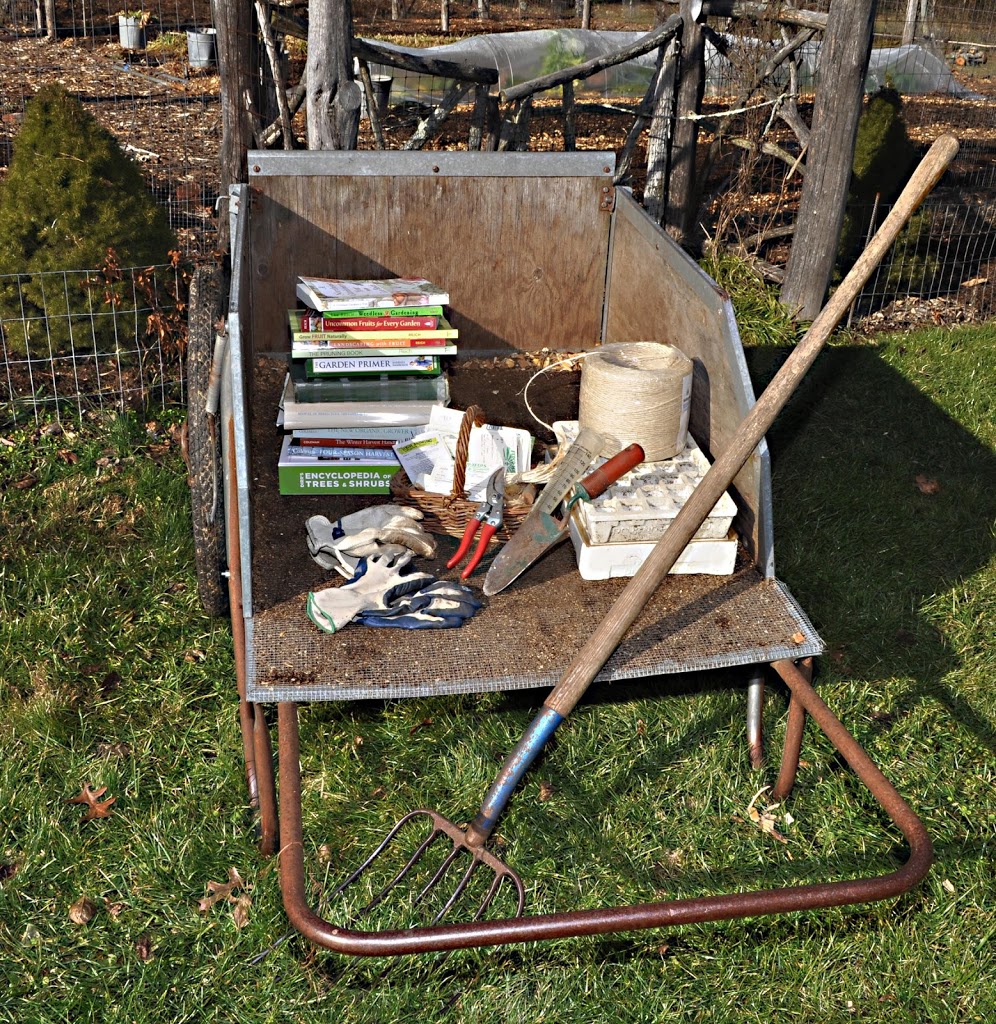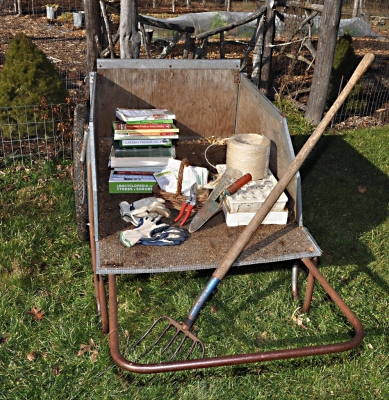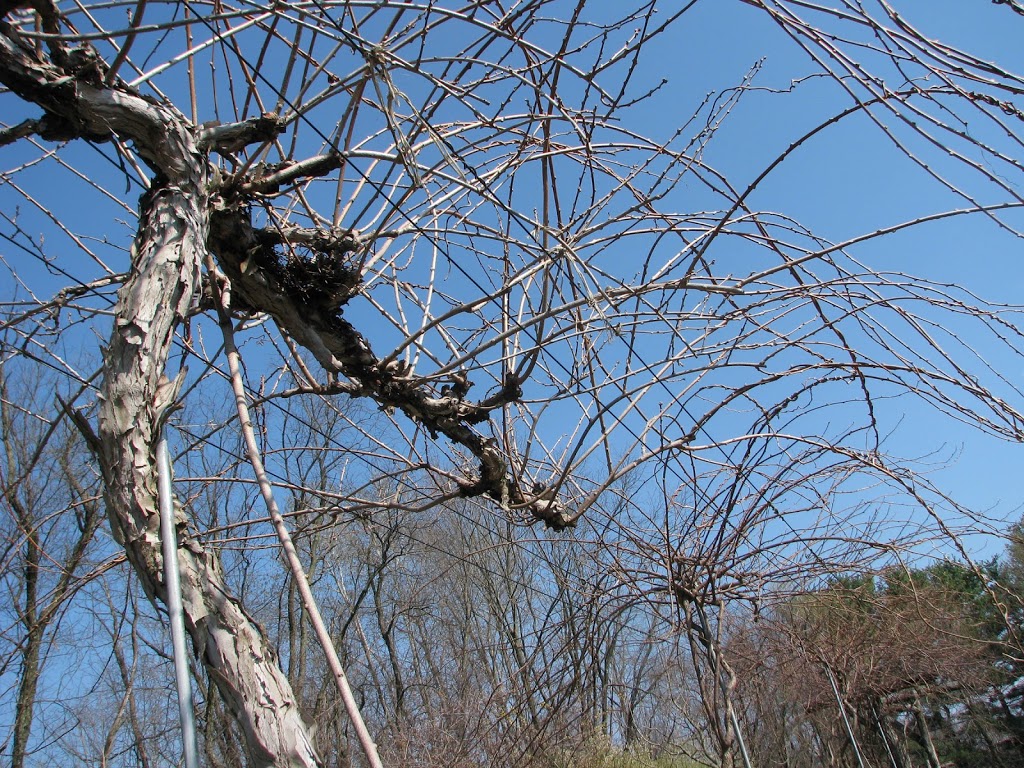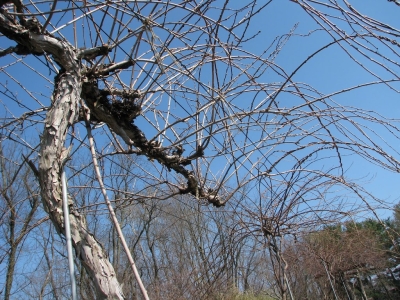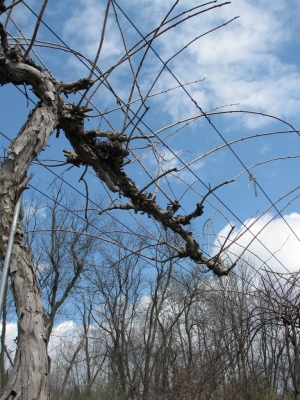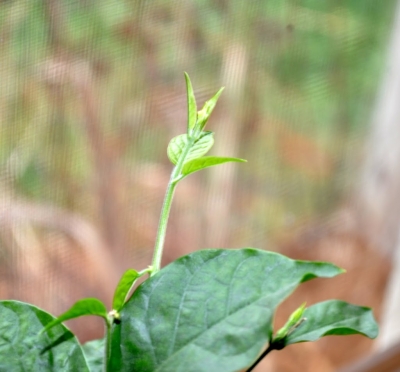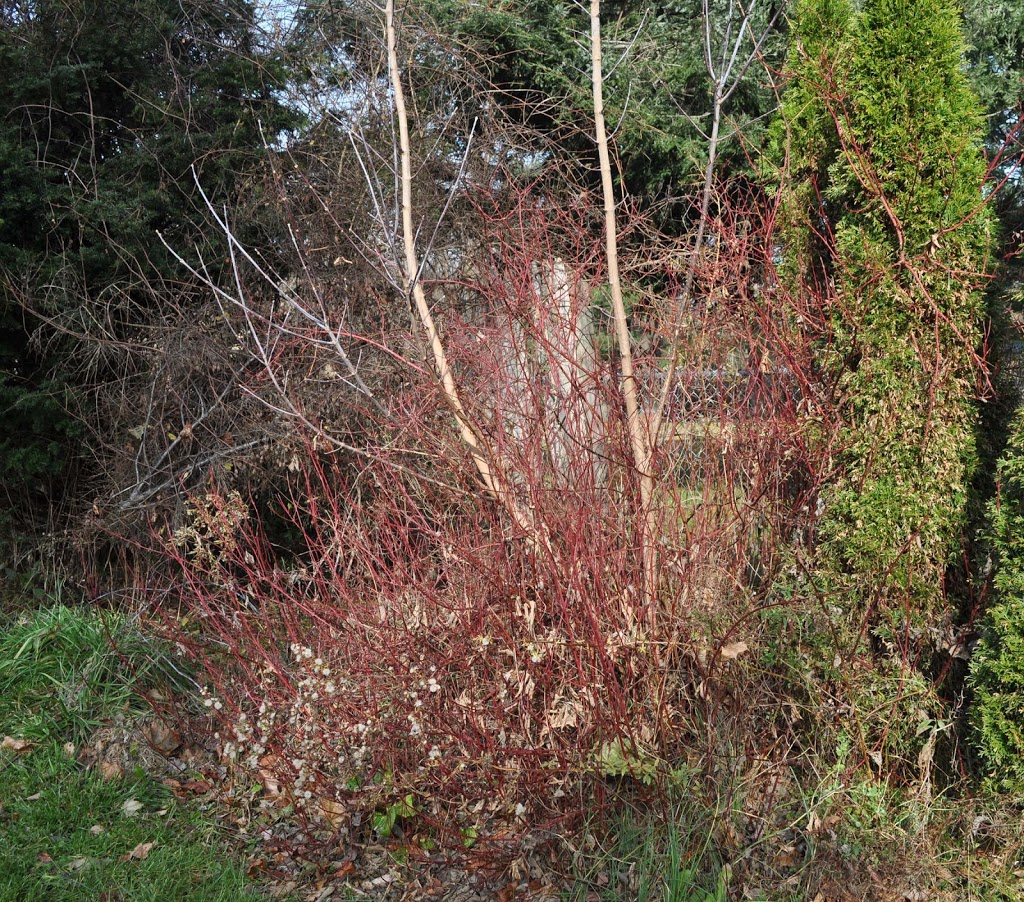Good Gifts for Gardeners
/4 Comments/in Books/by Lee A. Reich What would be a good gift for a gardener at this gift-giving time of year? Every gardener has his or her special inclinations, gardenwise, so each of us warrants a special set of gift possibilities.
Still, certain expendable items are sure to please any and every gardener. Tops on my list would be a big ball of twine. Twine is useful for everything from lashing blue spires of delphinium and floppy tomato vines to stakes to tying pea vines to a trellis or grape vines to support wires. Not just any twine will do; best is twine made of natural fibre, such as hemp or sisal, so that it can be gathered up to be composted along with the plants it supported at season’s end.
Gloves are another expendable item great for gifts. Gloves made from leather and some synthetics last for years. Among my favorite gloves for everything from detail work like transplanting small seedlings to grabbing a pitchfork to pitch manure onto the compost pile are knit gloves with nitrile or latex coated palms and fingers. With rough use, the gloves only last a couple of seasons, if that, but they’re worth it for their grippiness, comfort, and hand protection. I save my leather gloves for colder weather or for rougher work such as pruning thorny rose and gooseberry bushes and grabbing firewood.
Organic gardening (a good idea and the essence of good gardening in general) conjures up its own special gifts. Straw, manure, hay, leaves, wood chips, and other organic (that is, living or once-living) materials are what put the “organic” into organic gardening. A pitchfork is the perfect tool for moving organic materials to the compost pile or on top of the soil. But choosing a pitchfork is not all that straightforward. I am the proud owner and frequent user of 4-, 5-, 6-, and 10-tine pitchforks. Each has its special use but if I were to own just one pitchfork, it would be the 6-tine fork.
If you’re going to use a pitchfork, you’re probably going to need something with which to move around all those bulky organic materials. A garden cart. Stoked full, a sturdy cart with high wooden sides and two large-diameter tires can move over 10 cubic feet or 1/3 cubic yard of material, up to about 400 pounds of weight. Please don’t buy me one; I own three.
A few other essential, welcome tools are a trowel, which any but a beginning gardener is sure to have, and hand pruning shears (my favorite is ARS although Felco and Pica are also very, very good). A rain gauge is also essential to know whether what sounded like an earth-drenching downpour really contributed to the one inch per week needed for best plant growth. Good sources for tools are Gemplers, A. M. Leonard, Charleys Greenhouse, Orchard Equipment Supply Co., and Gardener’s Supply Co.
Beginning gardeners will appreciate packets of basic seeds such as Black Seeded Simpson and Buttercrunch lettuce, Bush Blue Lake and Romano beans, French Breakfast radishes, and Green Arrow peas. More advanced gardeners start their own transplants so might appreciate especially good, but hard to find as transplants, varieties of tomatoes, such as Blue Beech, Belgian Giant, San Marzano, and Black Krim. Johnny’s Selected Seeds, Fedco Seeds, High Mowing, Pinetree Garden Seeds, Tomato Growers Supply Company, and Totally Tomatoes are among my favorite seed companies. For growing transplants, I recommend Gardener’s Supply APS, which waters seedlings automatically and gives each seedling its own home so they hardly realize when they’ve been transplanted. I already own about a dozen of them so don’t buy one for me, thanks.
How about a gift of some of the above catalogues? How about including some good nursery catalogues also? Some of my favorite nurseries are Hartmann’s, Raintree, One Green World, Cummins, Burnt Ridge, and Nourse.
————————————–
The best gift for the beginning gardener or for the seasoned gardener who wants to grow better is, in my opinion, a good book. Among my favorites are any of Elliot Coleman’s books about vegetable gardening, any of Michael Dirr’s books about trees and shrubs, Steven Still’s Manual of Herbaceous Plants, Hartmann & Kester’s Plant Propagation: Principles and Practices, my bible on plant propagation, and, for general gardening, Roy Biles’ The Complete Book of Garden Magic and Barbara Damrosch’s The Garden Primer. For entertaining and informative essays, there’s Green Thoughts: A Writer in the Garden by Eleanor Perenyi and The Principles of Gardening: A Guide to the Art, History, Science, and Practice of Gardening by Hugh Johnson.
Oh, and did I mention my books?: A Northeast Gardener’s Year (the what, when, and how for a wide range of gardening topics arranged, as appropriate, through the year), Weedless Gardening (especially good for vegetable gardening), Uncommon Fruits for Every Garden, Landscaping with Fruit, and Grow Fruit Naturally.
————————————————————–
A Jump on Spring
/9 Comments/in Pruning/by Lee A. Reich
I got a jump on spring yesterday and started pruning hardy kiwifruit vines. The fruit is a kissing cousin of fuzzy, market kiwis, except, with smooth skins and small size, they can be popped whole in your mouth like grapes. Hardy kiwis are also cold-hardy, which their cousins are not.
The vines need yearly pruning to let light and air in among the stems for productivity and plant health, to keep fruiting stems within easy reach, and to stimulate new stem growth each year off which grow fruiting shoots the following year.
My plants are trained on 5 wires strung between T-trellises, one wire down the middle of the trellis flanked by 2 wires on either side of that central wire. Each plant’s trunk rises up to the middle wire and then divides into two cordons, or permanent arms, that run in opposite directions along the middle wire. Fruiting arms, which are 1-year-old stems, grow off perpendicularly to the cordon to drape down over the outside wires.
As I approached the vines with shears, lopper, and small saw in hand, the vines looked back at me like an intimidating, tangled mess. Three steps in pruning brought everything in order. I first cut back all fruiting arms to within a foot or so of the outside wire and shortened each cordon back to where it began growth last year. Arms bear fruiting shoots near their bases so don’t need the whole of their lanky stems. As to the cordons, if they were allowed to grow longer and longer, one plant would tangle into the next plant down the row.
Next, the hardest part: I reached into the remaining tangle to cut back fruiting arms that have, over the years, begun to originate further and further off the cordons. These got shortened so that new shoots, for fruit 2 years hence, would originate closer in to the cordons. Left to their own devices, as they are in the wild on the edges of Asian forests, the vines would be climbing 100 ft. high on anything on which they could grab hold.
Finally, I thinned out most of the remaining fruiting arms so that they are about a foot apart. I’ll do a final pruning in spring, thinning more where needed and shortening all fruiting arms to their final length of about 18 inches long.
I’m left now with a pile of prunings. Their intertwining stems make nice decoration. I could also save some for my cat. Kiwi stems have a pleasing effect on the cats, similar to catnip. In Asian zoos, they have been used to calm “large cats.”
————————————————-
What joy a mere sprout can foreshadow! Late last summer a gardening friend gave me some sprouts from her Maid of Orléans jasmine (Jasminum sambac). By the end of summer, a few of the cuttings had rooted and even flowered. The plant or its flower wouldn’t win (or lose) any beauty contests, but is well worth growing for its unabashed fragrance. The aroma is sweet and rich and not at all cloying, even after the flowers fade.
What’s more, this jasmine flowers freely. As a matter of fact, it just finished its second round of flowering. Contrast this behavior with my two plants of common jasmine (Jasminium officinale). These latter plants occasionally cough forth a few flowers in late winter but nothing like the profusion of white blossoms they once did. I’ve tried everything, from starting new plants from cuttings to pinching shoots all summer until August to keeping them cool in until late winter to keeping them dryish until late winter to keeping them cool and dryish until late winter to keeping them in the greenhouse to . . . you get the picture.
The only dark cloud hovering over my Maid of Orleans was the potting mix. Something seemed not quite right with it, having me worried that the plant might not grow or, worse, expire (as did the plant from the gardening friend from whom I got the cuttings). Not that this is a time of year to expect growth from any plant.
But now, that cloud has moved on. The new sprout looks happy and healthy and foretells of a fragrant future.
————————————————-
I mixed up a new batch of potting soil, which I’ll need anyway in a couple of months for indoor sowing of the first seeds of next season. Into a 5 gallon bucket went finished compost and soil, equal parts, sifted. Into another 5 gallon bucket went peat moss and perlite, equal parts, sifted. I tipped the contents of both buckets together into the garden cart, sprinkled on 1 cup of soybean meal and a handful of kelp, and repeatedly slid a flat-bladed shovel under the pile and turned it over and over. Once everything was thoroughly mixed, I shook and forced it again through the 1/2-inch sieve and packed it away into buckets.
This potting mix will be home to the roots of seedlings and houseplants, as well as large, potted fig trees, roses, and pomegranates. Also, to Maid of Orleans, as soon as she outgrows her present quarters.
PRUNING, I CAN’T RESIST
/4 Comments/in Pruning/by Lee A. Reich Now is generally not a good time for pruning outdoor plants. Too bad. With the lawn nicely trimmed and vegetable and flower beds tidied up, it’s all the more difficult to resist the urge to lop back at least some misplaced or congested stems on trees, shrubs, and vines.
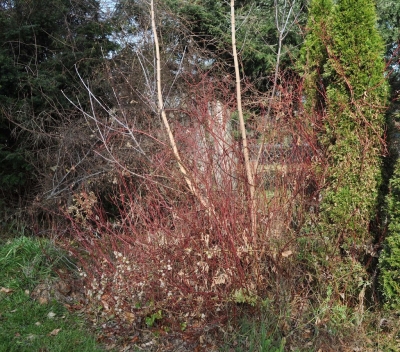 |
| Redosier dogwood, neglected |
I can’t resist. I figure little or no harm should come as long as I choose carefully what to cut. One reason not to prune now is that any wounding — and pruning does wound — stimulates a certain amount of cellular activity near the cut at a time when plants should be hunkering down for winter. Resulting cold injury can be minimized or nonexistent if pruning is restricted to the most cold-hardy plants. Also, gaping wounds won’t heal until spring so are open to pests. Here I rationalize that problems will be, again, minimal or nonexistent if only naturally tough plants are pruned now.
I’ve been eyeing an ungainly redosier dogwood since leaves have dropped. Redosiers are super-hardy, shrubby plants that liven up the winter scene with their bright red or yellow stems. The time to prune these plants is in early spring, after enjoying the plant’s colorful stems all winter.
The problem is that my redosier dogwood has been neglected for years. Only the one-year old stems are colorful and, with years of neglect, few are evident amongst the older wood. The right way to prune this plant is to lop the whole shebang to the ground every year or two in spring. Doing so coaxes a slew of vigorous, new sprouts near or just below ground level. Come autumn, these sprouts are officially one-year old (that is, they’ve completed a whole season of growth) and need only crisp weather to bring out their brightest color.
I’m lopping my whole plant to the ground this week (in addition to the boxelder and other weedy plants that have sprouted up among it). The plant is very hardy, has nothing to show for winter, and pruning now leaves one less thing to do in spring.
 |
| Black & red currants, pruned |
Likewise very cold-hardy and likewise soon to feel the steel of my pruning shears are my currant and gooseberry plants. Gooseberries and red currants bear fruit on one-, two-, and three-year-old stems so I’ll be cutting down any stems older than three-years-old and thinning out the youngest stems so that they don’t crowd as they age. Black currants fruit best on one-year-old stems so I’ll cut down any stems that bore fruit this past summer and thin out young stems if they crowd too much. All these plants start growth very early in spring, which is one more reason to prune them now.
————————————————
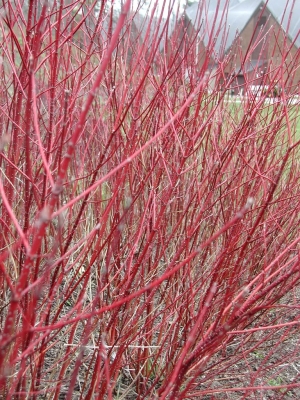 |
| Redosier dogwood, pruned & very red |
Stems don’t speak to me or bear age labels, so how do I know which ones are one- or two-years-old, or older? I look at them. With some plants, it’s very easy to tell. As I wrote, only the very youngest redosier dogwood stems turn red or yellow, with the help of cold weather. Kerria, also known as Japanese rose, blooms best on one-year-old wood, which broadcasts its age with its bright, green color; older stems are brown.
Other plants’ stems offer hints of their age even if they don’t colorfully broadcast it. Oldest stems generally are those that are the thickest. Stems also show their age in bark that starts to peel or gets bumpy or warty; that is, it looks old.
————————————————-
I’m not yet finished cutting. Lanky stems lash out and grab me as I pass across my terrace beneath the grape arbor, or walk down the field near the trellised kiwi vines. I’d like to prune them now, and I will, to some degree at least.
Kiwi expert Dave Jackson, who grows some of the best hardy kiwifruits I’ve ever tasted (www.kiwiberry.com), has 20 acres of the plants. He tells me that he prunes in autumn with no ill effect, so I’m tempted to do so also. Kiwis require more pruning that most plants and one reason he prunes in autumn could be because he wouldn’t have time to prune everything if he waited until spring.
Temperatures and airflow here at my farmden are not nearly as congenial for the plants as at Dave’s farm, which makes me wary of pruning my vines now. So I’ll prune a couple of my kiwi vines now and see how they fare. The rest will get pruned in spring.
But I’m going to shorten lanky stems on all the kiwi plants, as well as those on my grapes. Plants pack away food for winter in stems, so cutting stems does remove some winter stores; still, many stems, trunks, and roots will be left intact. Right near pruning cuts is where plants are most susceptible to damage. Shortening stems partially, rather than to their full length, avoids problems near the cuts. Final cuts can wait until spring.
————————————————-
Some plants needn’t feel even slightly threatened by my pruning shears — now, at least. Pruning butterfly bush in autumn, in my experience and that of many other gardeners, results in increased winter cold injury. Come spring, though, all their stems get lopped to the ground. I also won’t touch spring bloomers, such as lilac, forsythia, and mockorange bushes. Pruning would remove stems slated to bloom this spring. The time to prune these plants is right after they finish their flowery shows.
Want more on pruning? See my book, The Pruning Book (Taunton Press, 2010).

